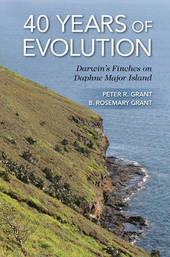
|
40 Years of Evolution: Darwin's Finches on Daphne Major Island
Hardback
Main Details
| Title |
40 Years of Evolution: Darwin's Finches on Daphne Major Island
|
| Authors and Contributors |
By (author) Peter R. Grant
|
|
By (author) B. Rosemary Grant
|
| Physical Properties |
| Format:Hardback | | Pages:432 | | Dimensions(mm): Height 235,Width 152 |
|
| Category/Genre | Birds |
|---|
| ISBN/Barcode |
9780691160467
|
| Classifications | Dewey:576.8 |
|---|
| Audience | | Tertiary Education (US: College) | | Professional & Vocational | |
|---|
| Illustrations |
44 color illus. 129 line illus. 21 tables.
|
|
Publishing Details |
| Publisher |
Princeton University Press
|
| Imprint |
Princeton University Press
|
| Publication Date |
6 April 2014 |
| Publication Country |
United States
|
Description
Renowned evolutionary biologists Peter and Rosemary Grant have produced landmark studies of the Galapagos finches first made famous by Charles Darwin. In How and Why Species Multiply, they offered a complete evolutionary history of Darwin's finches since their origin almost three million years ago. Now, in their richly illustrated new book, 40 Years of Evolution, the authors turn their attention to events taking place on a contemporary scale. By continuously tracking finch populations over a period of four decades, they uncover the causes and consequences of significant events leading to evolutionary changes in species. The authors used a vast and unparalleled range of ecological, behavioral, and genetic data--including song recordings, DNA analyses, and feeding and breeding behavior--to measure changes in finch populations on the small island of Daphne Major in the Galapagos archipelago. They find that natural selection happens repeatedly, that finches hybridize and exchange genes rarely, and that they compete for scarce food in times of drought, with the remarkable result that the finch populations today differ significantly in average beak size and shape from those of forty years ago. The authors' most spectacular discovery is the initiation and establishment of a new lineage that now behaves as a new species, differing from others in size, song, and other characteristics. The authors emphasize the immeasurable value of continuous long-term studies of natural populations and of critical opportunities for detecting and understanding rare but significant events. By following the fates of finches for several generations, 40 Years of Evolution offers unparalleled insights into ecological and evolutionary changes in natural environments.
Author Biography
Peter R. Grant and B. Rosemary Grant are both emeritus professors in the Department of Ecology and Evolutionary Biology at Princeton University. They are the coauthors of "How and Why Species Multiply" and coeditors of "In Search of the Causes of Evolution" (both Princeton).
ReviewsHonorable Mention for the 2015 PROSE Award in Biological Sciences, Association of American Publishers One of Choice's Outstanding Academic Titles for 2014 "For the Grants, Daphne Major has been a magic well. With their four decades of work on the island, they've made it a magnificent microcosm, a model of life on Earth."--Jonathan Weiner, New York Times "For the Grants, evolution isn't a theoretical abstraction. It's gritty and real and immediate and stunningly fast... Most of all, the book is an affirmation of the importance of long-term fieldwork as a way of capturing the true dynamism of evolution."--Joel Achenbach, Princeton Alumni Weekly "The study described here is truly exceptional. Peter and Rosemary Grant ... have devoted their careers to the study of the group of birds known as Darwin's finches on the Galapagos archipelago, one of the most isolated and inhospitable places on Earth. But the payoff is that their research furnishes some of the most compelling evidence for natural selection and the origin of species... The Grants' achievement is monumental."--Tim Birkhead, Times Higher Education "[O]ne of the most intriguing books I have ever read... Read it for yourself. You'll be glad you did!"--Allan Archer, BTO News "This volume not only provides detailed evidence of the evolution of a specific group of animals, but also offers an overall perspective on how and in what ways bird species have changed in this rather isolated locality."--Choice "Beauty is in the eyes of the beholder and 'best' is often a subjective term. In the case of the Grant's work on Galapagos finches, I think it is possible to argue objectively that it really is the best by some measures because of its design, sustained execution, and continual incorporation of new methods and ideas. This book contributes to the status of their research program because it makes this body of work readily accessible to a much larger audience."--David Reznick, Ecology "40 Years of Evolution offers readers numerous opportunities for inspiration at how the study of ecology, evolution, and natural history of finches on a small island reflects the forces at work in the Galapagos and throughout life."--Frederick R. Davis, Quarterly Review of Biology "This book uses hard won data ... to draw insightful conclusions about the messy, dynamic, and creative processes of evolutionary change and lineage divergence. It would make an excellent ... textbook for a college-level course in evolution because it has it all: natural selection, sexual selection, heritability, competition, character displacement, speciation, and extinction... This book is a tribute to the authors themselves."--Michael S. Webster, Evolution
|